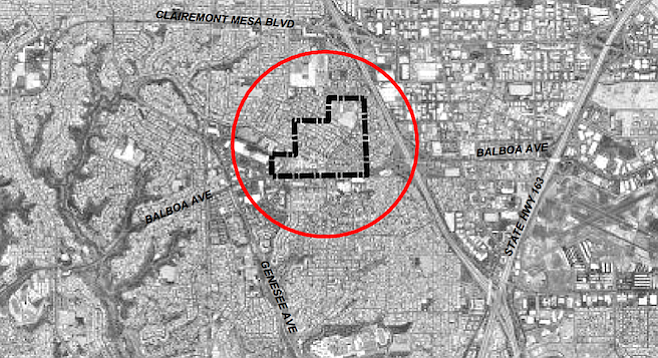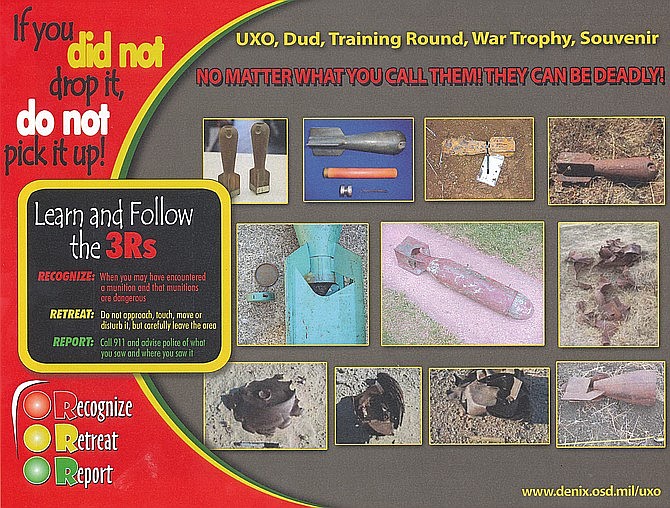 Facebook
Facebook
 X
X
 Instagram
Instagram
 TikTok
TikTok
 Youtube
Youtube

Janet Lancaster came armed with questions for U.S. Army Corps of Engineers program manager Jeff Armentrout on March 2. The town-council meeting had a modest turnout but all eyes and ears were at full attention when Armentrout took the microphone.
He reviewed the situation that prompted the meeting: the North Clairemont neighborhood used to be a 160-acre World War II practice bombing site called Rosedale Field.
The site was originally acquired by California in 1850 shortly before being admitted as the 31st state. The City of San Diego was granted the property in 1911. It’s unclear who held the property title in 1928 when the U.S. Navy was given permission to use the site.
In 1947, two years after WWII ended, the Navy decided they no longer needed the test-bombing site. In 1949, the Navy did a land exchange with the city. The city got Rosedale and the Navy got property in Point Loma, south of North Harbor Drive at Nimitz. From here the trail gets fuzzy again until development took over the area in the 1960s and 1970s.

Lancaster said to Armentrout, “I’ve owned my house since 1992 and I’m trying to figure out how come I’m being notified now, in 2017. Why wasn’t I notified in 2008 or 2009 when the site assessment was done? I’m trying to figure out what the trigger is for these letters now?”
Armentrout said the trigger had to do with the next step in the process — likely not happening for a while. Armentrout said they wanted to make sure that people were aware that they might be living on WWII-era munitions so they know what to do if they find anything resembling ordnance. “Recognize, retreat, and report” are the key instructions on the hand-out they distributed; in other words, step away and call 911 immediately.
When Lancaster asked when the next step might happen, Armentrout said a remedial investigation of the site would occur — but he couldn’t say when because of the cost and lack of funding. He said it’s not anticipated to be before 2085.
“So, when everyone in this room is dead,” responded Lancaster to laughs all around.
According to documentation, it looks like there was a preliminary assessment in 2006 where the original center of the bomb target was identified between two backyards. Armentrout mentioned that prior to that, two practice bombs were found in the former Rosedale area, one very close to someone’s backyard at the original center of the bomb target site (someone mentioned Clayford Street). The other one was also found in the area, but an exact location could not be determined after reviewing records and logs, said Armentrout. In 2009, a final site inspection report recommended a Remedial Investigation/Feasibility Study to ensure there were no dangers.

A member of the town council jokingly mentioned that he lives at “ground zero.” He wanted to ascertain if emergency response personnel were properly trained for calls about undetonated munitions. The crowd was assured by Armentrout’s colleague that local military is a resource for first responders.
After the meeting, Lancaster said, “I’m baffled at how few people give a shit about this issue. I find it hard to believe that someone at city hall didn't know about the airfield in 1964 when the houses were built….The city issues permits. Some developer got to make money, a mayor and/or city councilman got to create a favor in so doing and the public be damned…. This is a total ‘cover your ass’ move. And, believe me, if one of these detonated and hurt someone, the [Department of Defense] would not be released from liability. Even the answer to posting signs was lame. Why not err on the side of safety?”
Lancaster and other residents also have concerns about how this might impact their ability to sell their homes someday.
Lack of funding to detect buried bombs might have something to do with the fact that Armentrout said there are 10,000 sites like Rosedale across the nation. The degree of hazard in Clairemont is rated five on a scale from one to eight, with one being nuclear or chemical warfare.
Why were houses allowed to be built on a former bomb-testing site before being cleaned up? Were regulations that lax in the 1960s?
When I asked the city this, I was told that it’s a federal issue and that the city has limited to no information about it. It was suggested I contact MCAS Miramar. Captain Kurt Stahl from MCAS Miramar has some folks doing research and looking through old maps to see what they can find out, but it might take a couple of weeks to get any answers.
Arian Collins from city communications said, “As you can guess, there’s no one currently working at the city that was around at the time the land was transferred or when this development was taking place. Certainly a lot of grading of the land would have been done as well as the construction of homes and other structures. I do not know if any ordnances were found during this phase. That would likely require some digging into news articles from that time.”
Collins suggested a public records act request to track down whatever agreement was made between the city and U.S. government, and what was and wasn’t included as part of the land transfer.


Janet Lancaster came armed with questions for U.S. Army Corps of Engineers program manager Jeff Armentrout on March 2. The town-council meeting had a modest turnout but all eyes and ears were at full attention when Armentrout took the microphone.
He reviewed the situation that prompted the meeting: the North Clairemont neighborhood used to be a 160-acre World War II practice bombing site called Rosedale Field.
The site was originally acquired by California in 1850 shortly before being admitted as the 31st state. The City of San Diego was granted the property in 1911. It’s unclear who held the property title in 1928 when the U.S. Navy was given permission to use the site.
In 1947, two years after WWII ended, the Navy decided they no longer needed the test-bombing site. In 1949, the Navy did a land exchange with the city. The city got Rosedale and the Navy got property in Point Loma, south of North Harbor Drive at Nimitz. From here the trail gets fuzzy again until development took over the area in the 1960s and 1970s.

Lancaster said to Armentrout, “I’ve owned my house since 1992 and I’m trying to figure out how come I’m being notified now, in 2017. Why wasn’t I notified in 2008 or 2009 when the site assessment was done? I’m trying to figure out what the trigger is for these letters now?”
Armentrout said the trigger had to do with the next step in the process — likely not happening for a while. Armentrout said they wanted to make sure that people were aware that they might be living on WWII-era munitions so they know what to do if they find anything resembling ordnance. “Recognize, retreat, and report” are the key instructions on the hand-out they distributed; in other words, step away and call 911 immediately.
When Lancaster asked when the next step might happen, Armentrout said a remedial investigation of the site would occur — but he couldn’t say when because of the cost and lack of funding. He said it’s not anticipated to be before 2085.
“So, when everyone in this room is dead,” responded Lancaster to laughs all around.
According to documentation, it looks like there was a preliminary assessment in 2006 where the original center of the bomb target was identified between two backyards. Armentrout mentioned that prior to that, two practice bombs were found in the former Rosedale area, one very close to someone’s backyard at the original center of the bomb target site (someone mentioned Clayford Street). The other one was also found in the area, but an exact location could not be determined after reviewing records and logs, said Armentrout. In 2009, a final site inspection report recommended a Remedial Investigation/Feasibility Study to ensure there were no dangers.

A member of the town council jokingly mentioned that he lives at “ground zero.” He wanted to ascertain if emergency response personnel were properly trained for calls about undetonated munitions. The crowd was assured by Armentrout’s colleague that local military is a resource for first responders.
After the meeting, Lancaster said, “I’m baffled at how few people give a shit about this issue. I find it hard to believe that someone at city hall didn't know about the airfield in 1964 when the houses were built….The city issues permits. Some developer got to make money, a mayor and/or city councilman got to create a favor in so doing and the public be damned…. This is a total ‘cover your ass’ move. And, believe me, if one of these detonated and hurt someone, the [Department of Defense] would not be released from liability. Even the answer to posting signs was lame. Why not err on the side of safety?”
Lancaster and other residents also have concerns about how this might impact their ability to sell their homes someday.
Lack of funding to detect buried bombs might have something to do with the fact that Armentrout said there are 10,000 sites like Rosedale across the nation. The degree of hazard in Clairemont is rated five on a scale from one to eight, with one being nuclear or chemical warfare.
Why were houses allowed to be built on a former bomb-testing site before being cleaned up? Were regulations that lax in the 1960s?
When I asked the city this, I was told that it’s a federal issue and that the city has limited to no information about it. It was suggested I contact MCAS Miramar. Captain Kurt Stahl from MCAS Miramar has some folks doing research and looking through old maps to see what they can find out, but it might take a couple of weeks to get any answers.
Arian Collins from city communications said, “As you can guess, there’s no one currently working at the city that was around at the time the land was transferred or when this development was taking place. Certainly a lot of grading of the land would have been done as well as the construction of homes and other structures. I do not know if any ordnances were found during this phase. That would likely require some digging into news articles from that time.”
Collins suggested a public records act request to track down whatever agreement was made between the city and U.S. government, and what was and wasn’t included as part of the land transfer.
Comments